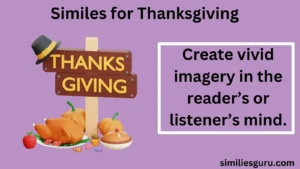Similes are some of the most versatile tools in language, helping writers and speakers add color, depth, and vivid imagery to communication. They are comparisons using the words “like” or “as”, and they make abstract concepts easier to understand by relating them to familiar ideas.
In this article, we’ll explore the many uses of similes, explain the nuances behind different tones (formal, casual, professional), and offer polite and modern alternatives for expressing “what are similes used for” depending on context.
Whether you’re crafting an academic paper, chatting with a friend, writing a business email, or creating engaging content, understanding how similes function — and how to talk about them properly — can significantly enhance your communication skills.
What Are Similes Used For? (An Overview)
At the most basic level, similes are used to:
- Create vivid images in the reader’s or listener’s mind.
- Clarify meaning by linking unknown ideas to familiar ones.
- Add emotional impact by evoking feelings and moods.
- Enhance storytelling by making narratives more engaging.
- Make communication more relatable and memorable.
A simple example:
- “She was as brave as a lion.”
Instead of just saying “She was brave,” the simile paints a richer picture, helping the audience immediately visualize and feel the courage.
Different Ways to Say “What Are Similes Used For?” (Polite, Professional, and Casual Alternatives)
Depending on your audience, you might want to rephrase “what are similes used for” in different ways. Here are some refined alternatives:
Polite Alternatives
- Could you explain the purpose of similes?
- May I ask how similes are typically used?
- Would you mind clarifying how similes enhance communication?
Professional Alternatives
- In what contexts are similes most effectively applied?
- How do similes function within literary or professional writing?
- What roles do similes play in communication and storytelling?
Casual Alternatives
- What’s the point of using similes?
- How are similes helpful?
- When would you use a simile instead of just saying something directly?
25+ Purposes for Using Similes
Let’s explore more than 25 different practical uses for similes across different areas of life:
1. To Paint a Vivid Mental Picture
Example:
- The sunset was like a painter’s dream splashed across the sky.
Tone nuance:
- Ideal for creative writing or storytelling where imagination matters.
2. To Make Abstract Concepts Concrete
Example:
- Love is like the wind — you can’t see it but you can feel it.
Tone nuance:
- Helpful in academic explanations or emotional speeches.
3. To Evoke Strong Emotions
Example:
- Her words cut like a knife.
Tone nuance:
- Used for dramatic storytelling or emotional dialogue.
4. To Add Humor
Example:
- He’s as clumsy as a newborn giraffe.
Tone nuance:
- Perfect for lighthearted or casual conversations.
5. To Simplify Complex Ideas
Example:
- Learning a new language is like planting a seed — it takes time and patience.
Tone nuance:
- Great for teaching, training, or public speaking.
6. To Strengthen Persuasion
Example:
- Making that decision without research is like diving into a pool without checking if there’s water.
Tone nuance:
- Useful for arguments or presentations.
7. To Add Rhythm and Musicality
Example:
- The words flowed like a gentle river.
Tone nuance:
- Enhances poetry and songwriting.
8. To Connect Culturally
Example:
- His smile was as warm as a summer barbecue.
Tone nuance:
- Makes writing relatable to a specific audience.
9. To Create Sympathetic Characters
Example:
- She was as fragile as a spider’s web.
Tone nuance:
- Important in character-driven stories.
10. To Exaggerate for Effect
Example:
- He ran like the wind.
Tone nuance:
- Often used in tall tales and hyperbolic storytelling.
11. To Highlight Differences
Example:
- Arguing with him is like trying to nail jelly to a wall.
12. To Emphasize Similarities
Example:
- Her laugh was like music to my ears.
13. To Set the Mood
Example:
- The night was as still as a graveyard.
14. To Create Suspense
Example:
- The silence was like a ticking bomb.
15. To Convey Movement
Example:
- The leaves danced like tiny ballerinas.
16. To Describe Sensations
Example:
- The soup was as hot as lava.
17. To Portray Sounds
Example:
- The door creaked like an old man groaning.
18. To Show Speed
Example:
- The car zoomed by like a bullet.
19. To Indicate Fragility
Example:
- Her confidence shattered like glass.
20. To Express Size
Example:
- The mansion was as vast as a football field.
21. To Capture Beauty
Example:
- Her eyes sparkled like stars.
22. To Symbolize Power
Example:
- The wrestler was as strong as an ox.
23. To Suggest Innocence
Example:
- The child was as pure as freshly fallen snow.
24. To Illustrate Fear
Example:
- He trembled like a leaf in the wind.
25. To Describe Difficulty
Example:
- Solving that puzzle was like finding a needle in a haystack.
26. To Enhance Imagination
Example:
- The dream floated away like mist at dawn.
10 Texting Examples for “What Are Similes Used For?”
Here are 10 short, user-friendly texting examples optimized to look clean and natural in conversation:
- “Hey! Quick question: what’s the point of using similes?”
- “Can you remind me how similes help in writing?”
- “I’m stuck. When exactly should I use a simile?”
- “Is there a good reason to throw a simile into an essay?”
- “Are similes just for poetry or what?”
- “Why are similes even a thing in storytelling?”
- “Need help — when do people actually use similes?”
- “Curious: what do similes add to a description?”
- “Trying to make my speech better. Are similes worth it?”
- “Can you give me a quick example of why similes matter?”
How to Choose the Best Alternative for “What Are Similes Used For” (Based on Context)
| Context | Tone | Recommended Alternative |
| Academic Paper | Formal/Professional | How do similes function within literary analysis? |
| Business Presentation | Professional | In what contexts are similes most effectively applied? |
| Friendly Chat | Casual | What’s the point of using similes? |
| Training Session | Polite/Professional | Could you explain the purpose of similes? |
| Text Message | Casual | Need help — when do people actually use similes? |
Choosing the correct form based on your audience and setting ensures that your communication remains respectful, clear, and engaging.
Conclusion
Similes are not just a stylistic flourish; they are a fundamental part of effective communication across nearly every platform, from academic essays to casual texts. Understanding what similes are used for — and knowing how to talk about them in different tones — enriches your ability to connect with audiences on a deeper, more emotional level.
By exploring polite, professional, and casual alternatives to the phrase “what are similes used for,” and practicing with user-friendly examples, you’re better equipped to weave creativity, clarity, and relatability into your conversations and writing.
Never underestimate the power of a simple simile — sometimes, a comparison can say more than a thousand plain words.



